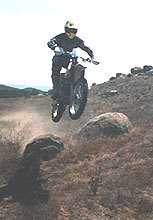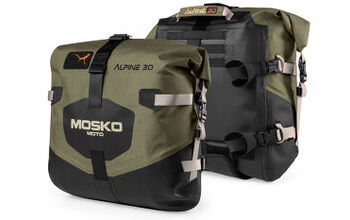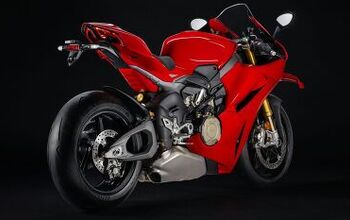Church of MO: Living With Honda's XR250R
Jan Brady was a middle sibling in the `70s sit-com The Brady Bunch, who got no respect as a result of her Coke-bottle glasses, lack of acting skills, and that none of the three Brady sisters on the show could hold a candle to the beauty of Alice the housekeeper. Which is kind of the situation the Honda XR250R found itself in 25 years ago – smaller-pistoned and therefore less desirable than the XR400 and XR650. Anyway, all those air-cooled beasts were unkillable when you could get them to (kick)start, and Honda will still sell you a brand-new XR650 if you desire one as Alice desired Sam the butcher.
that empty spot in your garage.
This bike is all it’s cracked up to be. What’s New? We were truly impressed by the performance of the new XR. No shortcuts here. Honda’s engineers have breathed new life into the powerplant, claiming higher torque and improved responsiveness. A new carburetor, lightweight dual exhaust and a freer-breathing muffler are now par for the course. A dry sump lubrication system, aluminum clutch center, trimmed-down balancer and kickstarter idle gears, as well as a hollow-section shifter shaft all help to reduce engine weight and size. A lighter, smaller frame is alleged to have increased rigidity and enhanced turning responsiveness over previous models.
Suspension and brakes, both front and rear, are entirely new. The transmission has been updated with a new involute spline countershaft that improves cog movement, a polished shift fork guide, and all-new gearshift cam design. For those of us with little idea of what an involute spline countershaft is, the changes translate into more precise shifting and less work than before.
“We rode the machine during several hot afternoons and never once experienced any noticeable decrease in horsepower or symptoms of engine overheating.”
The 250’s new kickstart mechanism is similar in design to that of the XR600R’s. Indeed, very little effort is required to crank the eager engine over. There are no systematic starting drills to adhere to either. In the event that it’s needed, the XR is equipped with a manual decompression lever.
It seems whenever we get a new dirt bike, our staff street-weenies bicker over who gets to climb aboard first. More accurately this begins the contest of who can fall off first. Well, our test of the XR was no exception and in no time the XR became the designated machine on which off-road neophytes would be schooled on how to do it in the dirt. Needless to say the XR soon was spending more time sliding on its side than rolling down the trail.
Even after a high speed high-side by one of our “evaluators” the bike suffered little more than scratches and a minimally tweaked front end. The forks twisted in their clamps but were quickly returned to their original position without any permanent damage. Suffice it to say the XR is extremely tough and great to learn on. Experienced riders will find they can travel at a brisk pace thanks to the XR’s sophisticated suspension, while our less-experienced friends will extol over the Honda’s user-friendliness.
Honda has scrapped the XR’s conventional lubricating system in place of an all-new dry sump design. The concept, claimed to markedly improve cooling, uses the front section of the frame as an oil reservoir . Oil is forced through the frame, while large cooling fins on the motor provide a departure point for heat. No complaints here. On several hot summer days we rode the machine all afternoon and never once experienced any noticeable decrease in horsepower or symptoms of engine overheating. In fact the lack of water cooling combined with a dry sump lubrication system keeps engine weight down to a mere 74.3 pounds.
In stock form the motor produces torque and horsepower at low to mid-range rpm ranges. Honda credits the XR’s grunt to a design concept they’ve utilized for over ten years. The Radial Four Valve Combustion chamber (RFVC) allows for the use of large valves, better flow and a unique valve actuating method. Due to the positioning of the sub-rocker arm, the rocker arm and valve operate on different planes, theoretically enabling the entire valve train to last longer. Power delivery is brisk by four-stroke quarter-liter standards. While considerable shifting is required to keep the fun happening in tight or sandy terrain, you can tool around all day on trails without necessitating a full Shim Sham tap dance routine on the shifter.
However, aggressive riders will be asking Santa for a few extra ponies come Christmas. Fortunately there are a plethora of aftermarket goods readily available, including kits to boost displacement to a full 300cc.
Clutch action is surprisingly light and smooth. Our clutch held up well despite a day of heavy flogging out at the MO sand track. In fact all of the controls, borrowed directly from the CR motocrossers, worked well and proved easily adjustable.
Stopping the thumper are the same high quality Nissan units found on Honda’s MX machines. There is no shortage of braking power here. As with our XR400, action is extremely light and resistant to fade at both ends. Suspending the XR up front is a pair of fat 41mm cartridge forks with 10.6 inches of front wheel travel and 20-position compression damping adjustments. The new configuration reduces underhang significantly over the old design. Construction is similar to that used on the CBR900RR street rocket. In the rear a Showa single shock features 20-position compression and rebound damping adjustability.
Flimsy plastic brush guards, an Enduro style headlight, resettable odometer, folding footpegs, O-ring chain, snail-cam adjusters, and a quick detach rear wheel make for a complete offering. While we did manage to bend the folding shift lever, it withstood some serious rock abuse and bent back without showing signs of weakness.
“A hinged-cover airbox makes for one of the best designs we’ve seen in terms of air filter serviceability.”
The combination headlight/numberplate design is first rate; the multi-piece assembly quickly detaches when you don’t need it. And since it’s two separate components, the likelihood of having to replace both in a crash is reduced. In the event it is needed, Honda offers an optional 55W bulb over the stock 35W. A short 55.1 inch wheelbase combined with a 24 degree rake make for a fast-handling unit. However, straight line stability is slightly compromised as a result. Despite tinkering with the suspension we were unable to eliminate some minor headshake experienced primarily under deceleration. The condition sometimes occurred while gassing it up at speed, but under these circumstances it was more manageable.
Details
Bodywork is sleek, and quick to remove. The low seat height and overall ergonomics make for a comfortable fit for most riders. The seat is comfy and slim, as is the tank, allowing the rider to move around without restriction. The engine’s gear driven counterbalancing system does a great job of reducing vibration to the handlebars, and the all-new exhaust system features a spark arrestor and removable baffle. A hinged-cover airbox makes for one of the best designs we’ve seen in terms of air filter serviceability.
The 1997 model is identical to last year’s with the exception of a new white, red and black color scheme, like that used by Honda’s off-road racing team. The suggested retail price for the ’97 model is $4599. Combine that with a transferable six-month warranty and you’ve got the ingredients for one of the best beginner off-road recreational packages available.
Specifications:
Year: 1995 1996 Capacity: 249cc 249cc Bore & Stroke: 73 by 59.5mm 73 by 59.5mm Compression Ratio: 10.2:1 10.2:1 Valve Head Size: 28.5/23.5mm 28.5/23.5mm Valve Stem Size: 5.5mm 5mm Valve Lift: 8/7.5mm 8mm Transmission: 6-speed 6-speed Engine Weight: 75 lbs 74.3 lbs Oil Capacity: 1.7 quarts 1.8 quarts Carburetor Size: 30mm 30mm Rake: 25 degrees 24 degrees Trail: 100mm 92mm Swingarm: 530 by 30 by 65mm 514 by 30 by 65mm Fork Size: 41mm 41mm Front Wheel Travel: 11 inches 10.6 inches Rear Wheel Travel: 11 inches 10.6 inches Tire Size: 80/100-21 front. 80/100-21 front. 110/100-18 rear. 100/100-18 rear. Front Disc Size: 240mm 240mm Rear Disc Size: 220mm 220mm Fuel Capacity: 2.4 gallons 2.4 gallons Wheelbase: 55.7 inches 55.1 inches Seat Height: 36.4 inches 36 inches Dry Weight: 245.8 lbs. 240.3 lbs.
More by John Burns



































Comments
Join the conversation
Hoping to score a clean one some fine day.